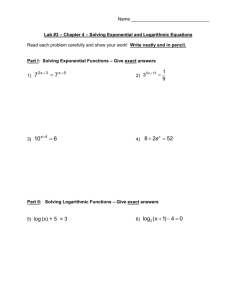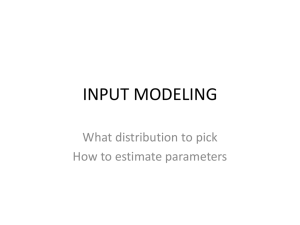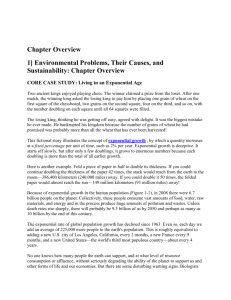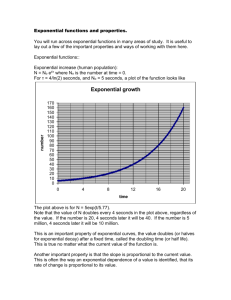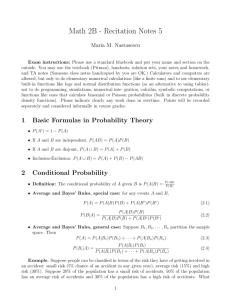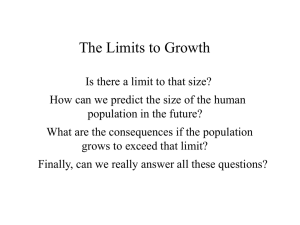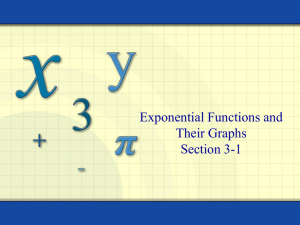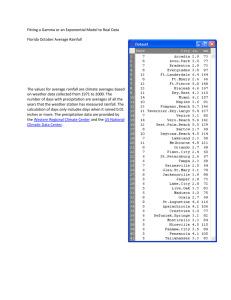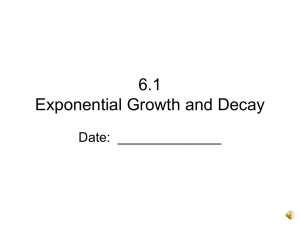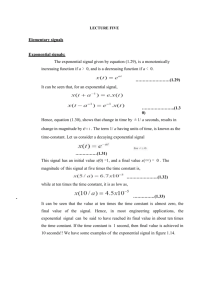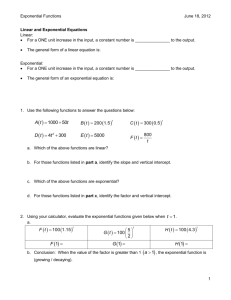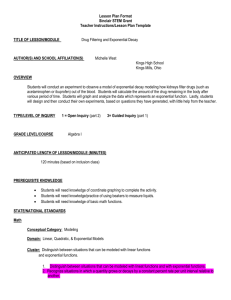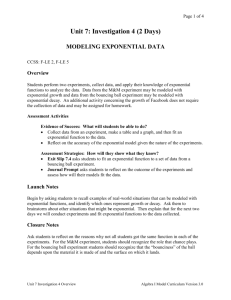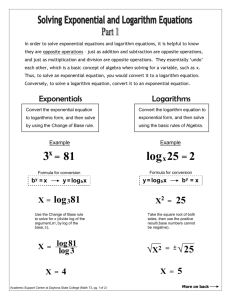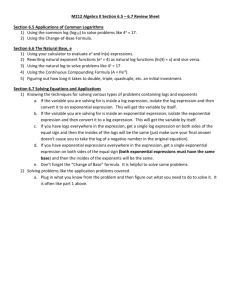S515 HW#3 (due on 3/2/11) SOLUTION Professor H
advertisement
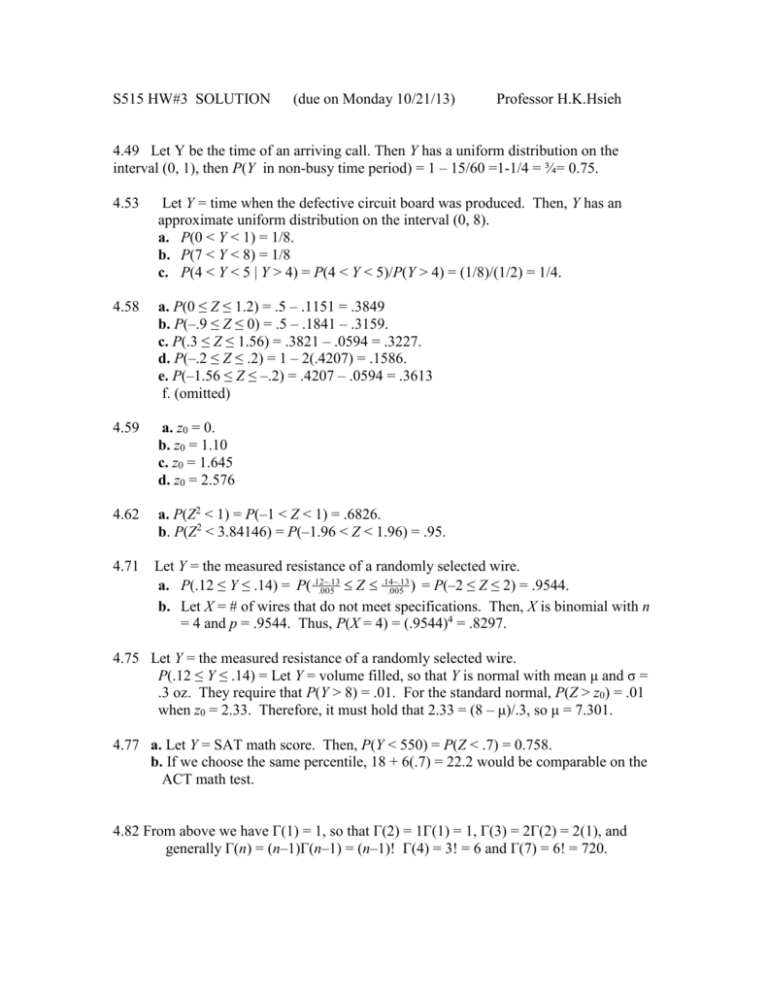
S515 HW#3 SOLUTION (due on Monday 10/21/13) Professor H.K.Hsieh 4.49 Let Y be the time of an arriving call. Then Y has a uniform distribution on the interval (0, 1), then P(Y in non-busy time period) = 1 – 15/60 =1-1/4 = ¾= 0.75. 4.53 Let Y = time when the defective circuit board was produced. Then, Y has an approximate uniform distribution on the interval (0, 8). a. P(0 < Y < 1) = 1/8. b. P(7 < Y < 8) = 1/8 c. P(4 < Y < 5 | Y > 4) = P(4 < Y < 5)/P(Y > 4) = (1/8)/(1/2) = 1/4. 4.58 a. P(0 ≤ Z ≤ 1.2) = .5 – .1151 = .3849 b. P(–.9 ≤ Z ≤ 0) = .5 – .1841 – .3159. c. P(.3 ≤ Z ≤ 1.56) = .3821 – .0594 = .3227. d. P(–.2 ≤ Z ≤ .2) = 1 – 2(.4207) = .1586. e. P(–1.56 ≤ Z ≤ –.2) = .4207 – .0594 = .3613 f. (omitted) 4.59 a. z0 = 0. b. z0 = 1.10 c. z0 = 1.645 d. z0 = 2.576 4.62 a. P(Z2 < 1) = P(–1 < Z < 1) = .6826. b. P(Z2 < 3.84146) = P(–1.96 < Z < 1.96) = .95. 4.71 Let Y = the measured resistance of a randomly selected wire. .13 .13 Z .14.005 ) = P(–2 ≤ Z ≤ 2) = .9544. a. P(.12 ≤ Y ≤ .14) = P( .12.005 b. Let X = # of wires that do not meet specifications. Then, X is binomial with n = 4 and p = .9544. Thus, P(X = 4) = (.9544)4 = .8297. 4.75 Let Y = the measured resistance of a randomly selected wire. P(.12 ≤ Y ≤ .14) = Let Y = volume filled, so that Y is normal with mean μ and σ = .3 oz. They require that P(Y > 8) = .01. For the standard normal, P(Z > z0) = .01 when z0 = 2.33. Therefore, it must hold that 2.33 = (8 – μ)/.3, so μ = 7.301. 4.77 a. Let Y = SAT math score. Then, P(Y < 550) = P(Z < .7) = 0.758. b. If we choose the same percentile, 18 + 6(.7) = 22.2 would be comparable on the ACT math test. 4.82 From above we have Γ(1) = 1, so that Γ(2) = 1Γ(1) = 1, Γ(3) = 2Γ(2) = 2(1), and generally Γ(n) = (n–1)Γ(n–1) = (n–1)! Γ(4) = 3! = 6 and Γ(7) = 6! = 720. 4.88 Let Y have an exponential distribution with β = 2.4. a. P(Y > 3) = 1 y / 2.4 2.4 e dy e 3 / 2.4 = .2865. 3 3 b. P(2 Y 3) 21.4 e y / 2.4 dy = .1481. 2 4.90 Let Y = magnitude of the earthquake which is exponential with β = 2.4. Let X = # of earthquakes that exceed 5.0 on the Richter scale. Therefore, X is binomial with n = 10 and p = P(Y > 5) = 1 y / 2.4 2.4 e dy e 5 / 2.4 = .1245. Finally, the probability 5 of interest is P(X ≥ 1) = 1 – P(X = 0) = 1 – (.8755)10 = 1 – .2646 = .7354. 4.93 Let Y = time between fatal airplane accidents. So, Y is exponential with β = 44 days. 31 a. P(Y ≤ 31) = 1 y / 44 44 e dy 1 e 31/ 44 = .5057. 0 E (Y ) y a a 1 ( ) y 1 y / e dy 1 ( ) 0 y a 1 y / e dy ( a ) a 1 1 ( ) ((a) ) a 0 2 b. V(Y) = 44 = 1936. 4.96 a. The density function f (y) is in the form of a gamma density with α = 4 and β = 2. 1 1 Thus, k = . 4 96 (4)2 b. Y has a χ2 distribution with ν = 2(4) = 8 degrees of freedom. c. E(Y) = 4(2) = 8, V(Y) = 4(22) = 16. 4.103 σ = 16 = 4. Let R denote the radius of a crater. Therefore, R is exponential w/ β = 10 and the area is A = πR2. Thus, E(A) = E(πR2) = πE(R2) = π(100 + 100) = 200π. V(A) = E(A2) – [E(A)]2 = π2[E(R4) – 2002] = π2[240,000 – 2002] = 200,000π , where E(R ) = 2 4 0 1 10 r 4 e r / 10 dr = 104Γ(5) = 240.000. 4.109 E (Y ) y a a 1 ( ) y 1 y / e dy 1 ( ) 0 y a 1 y / e dy ( a ) a 1 1 ( ) ((a) ) a 0 (See Problem 4.111 (a)) E(L)= E(30Y+2Y**2)=30E(Y)+2E(Y**2)= finish the rest V(L) =E(L**2) - [E(L)]**2 = E(900Y**2 + 120Y**3+4Y**4) - [E(L)]**2 = Use the general formula in the first line of this problem about high order moments and complete the rest y 4.126 a. F ( y ) (6t 6t 2 )dt 3 y 2 2 y 3 , 0 ≤ y ≤ 1. 0 0.0 0.5 1.0 1.5 F(y) = 0 for y < 0 and F(y) = 1 for y > 1. 0.0 0.2 0.4 0.6 0.8 1.0 y b. Solid line: f(y); dashed line: F(y) c. P( .5 ≤ Y ≤ .8 ) = F(.8) – F(.5) = [ 3(.8)2 -2(.8)3 ] - [ 3(.5)2 -2(.5)3 ] = 1.92 – 1.092 - .75 + .25 = .396. 4.139 Using Ex. 4.137 with a = –3 and b = 4, it is trivial to see that the mgf for X is mX (t ) e4t m(3t ) e( 43 )t 9 t 2 2 /2 . By the uniqueness of mgfs, X is normal with mean 4 – 3μ and variance 9σ2. 4.186 Using the substitution u = ym/α in the integrals below, we find: E (Y ) y e m ym / m dy 1/ m 0 u 1 / m u e du 1 / m (1 1 / m) 0 E (Y ) y 2 m m1 y m / e dy 0 2/ m u 2 / m u e du 1 / m (1 2 / m) . 0 Thus, V (Y ) 2 / m [ (1 2 / m) 2 (1 1 / m)] . 4.190 a. For the exponential distribution, f (t ) 1 e t / and F (t ) 1 e t / . Thus, r(t) = 1/β. m 1 b. For the Weibull, f ( y ) my e y / and F ( y ) 1 e y which is an increasing function of t when m > 1. m m / . Thus, r(t ) my m 1 ,



